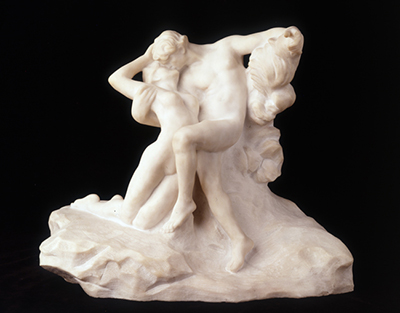While some artists thrive in painting, some find painting a little too simple to bring out their prowess in art. Auguste Rodin is one French artist who thought of sculpting his thoughts into real figures in perfect curves and arcs. Eternal Springtime is one of his most celebrated artworks depicting maturity in his career.
Rodin in this erotic sculpture portrays two lovers in a passionate moment. The way the two lean figures hang precariously in space as they demonstrate their love towards each other is a sign that the artist had soared into a different level in sculpting. A single look at the sculpture is not enough to praise this famous piece.
The male figure, which is the dominant piece ascends and descends in motion to meet his lover in a passionate kiss, holding the female figure which arches skillfully and willingly surrendering her love to the guy in a lovemaking scene. As the lady figure graces the ground with her legs lifting her upper body, her arced torso is held in a romantic embrace by her lover who poses on a rocky mount crossing his foot on his lover while extending his left foot beyond the base where the lady is kneeling as his left arm stretches out in the air.
The floating embrace was carefully crafted to bring out the contrasting features of the two subjects as they both gracefully depict the epitome of springtime love. This clay sculpture was molded at a time when Rodin had fallen in love with another sculptor Camille Claudel; who had joined him in his studios, with whom he had a romantic relationship while he was married. As a result, he decided to sculpt his forbidden love to his colleague. Though fused in an embrace, Rodin found a way to hide his tension melting the two lovebirds together. The piece was worked on while the artist was working on his array of sculptures for The Gates of Hell though it failed to be presented at the portal seemingly because it evoked a somewhat happy feeling between the subjects and would have been awkward to be in hell.
On the other hand, it is also noted that the female figure on this piece was based on Rodin's initial work; Torso of Adele, (Adele Abruzzesi), an Italian model who was one of the artist's favorite models. The similarity brought out in the Torso of Adele, and the female figure in Eternal Springtime is, the curves and arcs used both show a continuous movement. Based on the romantic inclination towards his fellow sculptor, it is not a surprise that Camille’s traces are visible in most of the female subjects of Rodin's famous works. Even though The Eternal Springtime severally received backlashes because of its eroticism, it is one of the most adored pieces by the artist and has been reproduced severally in marble and bronze.
Fascinated by the human body and its physicality, Rodin molded other sculptures including The Kiss, Eve, Eternal Idol and The Age of Bronze though none of these pieces are in their impressionistic form like the Eternal Springtime. Other famous works done by Rodin that are of the human body or parts of the human body but not in nudes include The Sirens, Two hands, Young Mother In The Grotto, The Thinker and The Burghers Of Calais. Rodin's love for the concave and convex curves inspired most of his works, most of which rests in a museum; Musee Rodin, which was set up in France in remembrance of his works. The artist perfected his rhythmic movements in sculptures while working for ornamentals during the 18th Century; thus when he finally matured his talent and decided to pave the way for himself, he arced most of his subjects to an inclination.
Rodin's Artworks and the Artists He Inspired
Apart from sculpting, the artist also painted some of his works on paper. These famous pieces include Love Turning The World, Portrait of Victor Hugo and Bust Of Bellona. His keenness on contrast is visible in most of his paintings, could be because he loved so much to differentiate his subjects alongside other objects on set. For instance, his paintings Golden Twilight On The Dunes In The Forest Of Soignes and Dirt Track To Watermael Through The Forest Of Soignes. Though most of his human body works were heavily criticized, he had followers like Alberto Giacometti who looked up to him with total admiration and came up with their variations of his pieces. Alberto, too, showed his love for the human body though he took a different angle to curve his pieces. Some of his works include Spoon Woman and Standing Woman.
Rodin was also a lover of unfinished works, though to him that was the way he wanted them portrayed. In the process, he mentored Eugene Carriere who intensely loved the pieces though he delved into brown monochrome painting. Rodin's works remain relevant to the present day because of his deviation from the traditional paintings. He is still remembered as one of the most outstanding sculptors who came up with unique human body pieces that deviated further from the art world allegories. While some of his works have been curved in marble to show the softer side of the real sculptures, the shiny bronze emulations give his works a total makeover.




